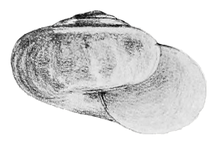Staffordia toruputuensis
| Staffordia toruputuensis | |
|---|---|

| |
| drawing of apertural view of the shell of Staffordia toruputuensis | |
| Scientific classification | |
| Domain: | Eukaryota |
| Kingdom: | Animalia |
| Phylum: | Mollusca |
| Class: | Gastropoda |
| Subclass: | Heterobranchia |
| Order: | Stylommatophora |
| Family: | Staffordiidae |
| Genus: | Staffordia |
| Species: | S. toruputuensis
|
| Binomial name | |
| Staffordia toruputuensis | |
Staffordia toruputuensis is a species of air-breathing land snail, terrestrial pulmonate gastropod mollusk in the family Staffordiidae.
The specific name toruputuensis is apparently according to its type locality, Toruputu Peak.
Distribution[edit]
The type locality of this species is "Toruputu Peak".[1] The altitude was not specified, but it can vary from 1750 m (birdwatching of the same author)[2] to 7,000 feet (2,100 m) (locality of related species Staffordia staffordi).[1] It is in Dafla Hills in India, because whole family Staffordiidae is endemic to Dafla Hills.[3]
Description[edit]
The shell is globose with oblique columellar margin.[1] The shell of the type specimen is not fully grown.[1] The sculpture is very smooth, with a thick shining epidermis with indistinct striation.[1] The color is light ochraceous olive-green.[1]
The width of the shell is 14.0-16.5 mm.[1] The height of the shell is 7.25 mm.[1]
References[edit]
This article incorporates public domain text from the reference.[1]
- ^ a b c d e f g h i Godwin-Austen H. H. (1907). Land and freshwater mollusca of India, including South Arabia, Baluchistan, Afghanistan, Kashmir, Nepal, Burma, Pegu, Tenasserim, Malaya Peninsula, Ceylon and other islands of the Indian Ocean; Supplementary to Masers Theobald and Hanley's Conchologica Indica. Taylor and Francis, London. 2: page 185, plate CXIII, figure 3.
- ^ "BEAUTIFUL NUTHATCH Sitta formosa". page 2279. In: Threatened birds of Asia. PDF.
- ^ Hausdorf B. (2000). "Biogeography of the Limacoidea sensu lato (Gastropoda: Stylommatophora): Vicariance Events and Long-Distance Dispersal". Journal of Biogeography 27(2): 379-390. doi:10.1046/j.1365-2699.2000.00403.x, JSTOR.
